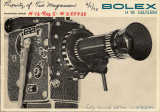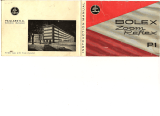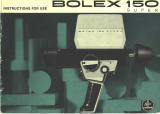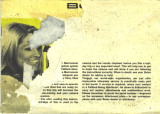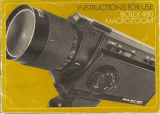Page is loading ...

Super 8 cartridge projector
Instruction manual
Be
)Le::x
MULTIMATIC®
BOLEX
MIJL\I.
MAT\C

3 vital hints
1. Do not forget to attach the end of the film
properly
in the core
of
the reel.
2. Add new
cartridges
or
change the
order
of
cartridges
only
at
the beginning of the
projection
of a film
or
during
a pause in pro-
jection.
3. Should the film stop suddenly, immediately press the still
pro-
jection
key (
-)
to avoid burning the film, and stop the
projector
.
(See
sect
ion "
Projection
troubles
".
)
Description
1. Cartridge
compartment
door
2.
Intermission lamp
3.
Cartridge pressure plate
4. Speed
selector
5.
Cartridge
changing
key
6. Film reinsertion lever
7.
Forward
or
reverse projection key
8. Normal speed
or
slow motion key
9. Still
projection
key
10.
Milled knob
for
adjusting height by means of front foot
11
. Lens cover
12.
Light adjustment knob
13
. Zoom
control
14
. Focusing knob
15
. Framing knob
16.
Red
rewind
indicator
Power supply:
3 models
-
120
V/60 Hz
-110--250 V/
50
Hz *
-
220
V/50 Hz *
* Not valid
for
the U.S.A. and Canada.
Halogen lamp:
21
V
150
W (code EJA)
15
V
150
W
15V
150W
The
110-250
V/
50
Hz model can be adjusted
for
60
Hz by
your
local
Bolex dealer.
Lenses available: - Paillard-Bolex Hi-Fi
-Ke
rn
Va
rio-Switar
20
mm I f
1.3
23
mm I f 1.1
zoom
17
- 34 mm I f 1
.1
zoom
12-
30 mm I f 1
.3
Bolex International S.A. res
er
ves the
ri
ght to modify, without
prior
notification, the
design
and features of the equipment
descr
ibed in
this manual.

_--
- 4
_---
6
_---9
=--_--------10
_____
------11

General
The Bolex
Multimat
ic
projector
takes both Super 8 and Single 8 films.
In
order
to ensure au
tomatic
operation, the end of the film must be
attached securely
to
the
core
of the reel. The type
of
clip
differs
accord
ing to the type of reels used. The clips are supplied with the
cartridges
.
Remarks
The
Bolex
Multimatic
projector
is
designed
for
use with
standard
50
' reels having a 74 mm
diameter
and a
slot
on
one side
of
the rim only. (Reels with a
slot
extending
to
both
sides
of
the rim are unsuitable.) Single 8
films
must be wound
on standard reels. Extra
cartridges
, containing an empty
standard reel, are available from
your
local
Bolex
dealer
. (See
section
"Accessories
",
page 16).
The
reel must contain
at
least 33'
of
film (50' in the case
of film on polyester base,
for
example Single 8),
which
corresponds to a
diameter
of
about
2".
On the
other
hand,
it should not be
too
full ; always leave a space
of
at
least
1i5t
h inch between the film and the sides
of
the reel,
which
cor
responds
to
a maximum
of
50
feet of film (80 feet of
film
on
po
lyester base.
Reel without built-in clipping device
With the reel laying flat on a table, full rim towards the top, place
clip
(a) over both sides of the end of the film
pr
otruding
in the core of the
reel and press
down
spr
ing.
Make sure
that
the clip
grips
the film
correctly
and
that
it does
not
project
beyond the sides of the reel.
For removing the
clipping
device,
slip
a pointed
object
under
the
spring, as indicated by the
arrow
, while holding the clipping device
firmly
with the fingernail.
2

Reel with built-in clipping device
Only the angle clip (b) may be used.
Push
clip
(b) fully home.
Cutting the film
Remove the side cover with the film
cutter
inside (see section
"Maintenance",
page 14). Cut the
beginning
of
the film leader.
Throw
away the
cut
off
part. There must be at least 1 ft.
of
leader before
the
first
splice
in the film.
In addition, the leader must be curved in the same
direction
as the
film on the reel.
If
it
curves too much
or
curves in the opposite
direction
, give
it
the
correct
ourve by
sliding
it between thumb and
forefinger.
3

Inserting the reels
in
the cartridges
~
d
c) film
guide
d) plug
Insert the reel into the
cartridge
at
a
slight
angle, with the film
tightly
wound, in the
direction
of
the
engraved arrow, in the bottom
of
the
cartridge
, the
film
perforations
towards
the
bottom
of
the
cartridge
and the
film
guide
(c) inserted between the sides of the
reel.
Press the plug (d)
firmly
onto the
cartridge
spindle.
Make sure the reel
turns
freely inside
the
cartridge
(in a
clockwise
direction)
.
The film is
now
permanently
in the
cartridge
.
Attach
a label, showing
the
subject
or
title
of
the film, onto
the space
prov
ided on
the
cartridge.
(A
strip
of
adhesive labels is
supplied
with
the
cartridges.)
4

If you
want
to remove the reel from the
cartridge
, press
obliquely
and push
the
end
of
a
pencil
firmly
against the
spindle
of
the plug.
Preparing for projection
(Not valid
for
the U.S.A. and Canada)
On the
110-250
V
mode
l
only
set the
voltage
selector
by means
of
a
coin
and, if necessary,
insert
the fuse
corresponding
to the
voltage
.
For voltages
up
to 145 V:
2.5A
fuse. For
voltages
above 145 V:
1.25A
fuse. (See section "
Maintenance"
, page 15.)
Plug
power
cable into outlet. The
intermission
lamp lights up.
5

Open the
lenscove~
Pull down
the
cartridge
compart-
ment
doo~
(This starts
the
pro-
jector,
switches
on
the
projection
lamp, and
turns
off
the
intermis-
sion lamp.)
Insert an
empty
cartridge
,
or
keep
plate (e)
depressed
.
6
Focus the frame
of
the
illuminated area
roughly
on the screen.
Adjust
the
height
and level the image.

If
your
projector
is
equipped
with
a zoom lens,
adjust
the image to
the desired size by moving
the
zoom
control.
Close
the
cartridge
compartment
door
and remove
the
empty
cartridge,
if one was inserted.
Changing lens
For
changing
the
lens,
turn
the
focusing
knob
clockwise
as
far
as
it
will go,
which
will
release the
existing lens. Insert
the
new
lens.
With zoom lenses,
insert
the
lug
on
the
mount
holder
into
the
fork
(fl
of
the zoom
control
lever.
Press the lens
completely
into the
holder
against the stop. When the
zoom
lever is
operated
,
the
fork
(fl
should
move
the
zoom
compo-
nents inside
the
lens
while
the
focusing
knob
moves
the
entire
lens.
Important
Never place an
object
which
blocks
the
fan
opening
on the
projector.
7

Projection
Remark
If
the
cartridges
have been shaken
dur
ing
transport
,
especia
lly
with
partly
filled
reels, the film layers
may have
worked
loose and
conse-
quently
l
oading
may
not
take
place
automatically. As a safety
precau-
tion, therefore,
it
is re
commended
to
tighten
the films before
projec-
tion
by
manually
turning
the reels
clockwise.
After
pushing
back
the pressure plate, insert the
cartridges
in
the
desired
order. As much as 6
cartridges
can be inserted into the
projector
.
Insert
them
in
two
steps, as shown in
the
illustration
above.
Press the normal speed key (- ).
Lower
the
cartridge
compartment
door
. The film
will
automatically
load (if it
does
not
, see remark
on
opposite
page).
8

Set
the
speed
selector
to 18
or
24
f.
p.
s.
Remark
Should
a
film
not load automatically, move
the
film
reinsertion lever
over
for
3 seconds. Do
this
however
only
when
the
previous
film
has
been rewound (red
warning
light
off).
If this
lever
is
accidentally
moved
during
projection,
the
projector
will
stop
, and can be started again
only
when the lever is released.
9
Focus the picture. Frame
the
picture
.

Select
the
most
satisfactory
image
brightness. (The
lower
brightness
prolongs
the
life
of
the lamp).
The films are
projected
and
rewound automatically,
one
after
the
other,
without
any manual
operation. During
the
change
from
one film to
the
next,
the
light
is
automatically
reduced
by a shutter.
During
projection,
you may add
new
cartridges
or
change
the
order
of
the
cartridges.
Do this
however
only
at
the
beginning
of
the
projection
of a
film, i.e.
right
after
a
cartridge
has
changed,
because
the pressure
plate must
not
be moved
while
the
projector
is
changing
cartridges.
Projected
cartridges
may be
removed
at
any
time
after
they
have left the
rewinding
compart-
ment.
To
stop
projection
for
a moment,
close
the
cartridge
compartment
door. The
intermission
lamp lights
up
automatically
.
You can
reject
a
partially
projected
film
and
go
immediately
to the next
cartridge
by pressing
(1
second
at
least)
the
cartr
i
dge
changing
key
(+)
.
(Do
not
get
in
the
way
of
cartridges
coming
out
of
the
compartment.)
If you press
this
key
before
the
previous film has been
completely
rewound
(indicated
by
the
red
warning
light
on
the
side
of
the
projector),
the
cartridge
w"ill
not
change
until
rewinding
is com-
pleted.
10

At
the
end
of
projection,
wait
until
the last
film
has been rewound -
i.e.
until
the red li
ght
goes
out
-
before removing
the
last
cartridge
.
Never leave
partially
rewound
or
projected
film
in
the
projector,
as
the
leader
might
become
distorted
and
affect
perfect
operation
.
An
incorporated
screen
holder
is
provided
for
rapid
film
viewing.
This
can
be used if the
projector
is fitted
with
a zoom lens.
Pullout
the
holder
as
far
as
the
stop
and
place
the
screen, supplied
with
the
projector,
in one
of
the
grooves
of
the
holder
.
Adjust
the
focus
with
the zoom in
the
wide-angle
position
. Alternatively, you can
place
in
the
holder
a
ground
glass
or
a sheet
of
ground
acetate, its
translucency
serving as a screen.
Methods
of
operation
A. Forward
projection
.
B.
Projection
at
normal
speed
(18
or
24
f.
p.
s.).
C.
Reverse
projection
(instantaneous at all speeds). Depress the key
completely
and
hold
it
down
*.
D.
Slow
motion at 6
or
8
f.
p.
s.
('hrd
of
the
normal
speed set).
E.
Still
projection
(for
as long
as
the
key is depressed).
A
catathermic
fil
ter
automatically
drops
into place between lamp
and film.
* In reverse
projection
the
film is
not
rewound
entirely
in its
cartridge
.
Therefore, swi
tch
to
forward
projection
before
the
end
of
the film
has passed
through
the
projection
aperture. If
this
is
done
too late,
the
film will
stop
. You then have
two
alternatives:
11
1. If you wish to
show
the
film
again: 2. If you wish to go on to
the
next
film:
with the red
warning
light
off,
move the film reinsertion lever
over
for
3 seconds.
(See page 9.)
press
the
switch
(+)
to remove
the
cartridge
.
If
the
red
warning
light
is on,
the
cartridge
will
not
change
until
rewinding
is
completed
.

Projection problems
an
d how
to
remedy them 12
Problem
A
cartridge
does
not
move
freely
into
projection
position
or
is
stuck
.
The
film
in one of
the
cartridges
is
not
projected.
The
cartridge
changes
normally,
but
the
pictures
from
the
next film
do
not
appear
and
the
screen remains
brightly
lit.
The
cartridge
does
not
change
(no
audible
click), and the screen
remains
brightly
lit.
Picture
unsteady and
cartridge
sometimes changes at
wrong
time.
Cartridge
change
s at the
wrong
time.
Probable cause
a)
Inserting
new
films
while
a
cartridge
is being changed.
b)
Cartridge
damaged
or
bent.
Label
glued
on badly.
a)
The film is
not
wound
tight
enough on
the
reel.
b) Faulty
leader
on
the
film.
The
film
retaining
clip
in the
core
of
the
reel is missing and all the
film
is
wound
up
on the take-up
reel -
check
by removing
the
side
cover. (See section "
Main-
tenance".)
a)
The reel
does
not
turn freely
inside
the
cartridge
.
b)
A take-up reel does
not
turn
freely.
Film in
poor
condition
(torn).
Poor
splice
.
Remedy
Stop
the
projector
and remove the
other
cartridges
from the
com-
partment. Rewind by hand the
portion
of
film
already engaged,
by
turning
the reel in the
cartridge
clockwise
,
and
remove the
blocked
cartridge.
Replace the
damaged
cartridge
.
Attach
the
label
only
in the space provided.
Move the film reinsertion lever over
for
3
seconds
. If necessary,
remove
the
cartridge
and tighten the film. (See section
"
Projection",
Remark.)
Remove the reel from
the
cartridge
and
straighten
or
cut
the damaged
portion
of
the
leader
.
Remove the
take-up
reel (see
section
"
Cleaning
") and rewind the
film
by
hand on
the
original
reel. Never leave the film on one
of
the
take-up reels
or
it
will
interfere
with
the
loading
of
another
film.
Change
the
cartridge
plug.
Make sure
that
the channel
cover
is
properly
centered. (See
section
"
Maintenance"
.)
Remove the
damaged
portion
.
Make a new
splice
.

The film breaks
during
projection.
Poor
splice.
The
cartridge
is
not
changed, and Damaged
perforations
at
the
end
the film
stops
at the end
of
pro-
of the film.
jection.
The lens
cover
does
not
close
. Hinge pin
out
of
position
.
13
Immediately press
the
still
projection
key
(-)
to
insertthecatathermic
filter
between lamp and film. Without releasing
the
pressure on
the
key:
-remove all
the
cartridges
except
the
one being
projected;
-press the key
(+)
to remove the remaining
cartridge
and rewind
the portion
of
film already engaged. If
the
red
warning
light is on,
keep the key ( - ) depressed until
the
previous film is rewound.
Stop
the
projector
by
closing
the
cartridge
compartment
door.
Open
the
side
cover
(see section
"Maintenance")
and remove the
projected
portion
of
the
film. If it
cannot
be reached, remove the
film
channel
cover
and, if necessary, the
take-up
reel with the
wound-up
film.
Press
immediately
on
the
cartridge
changing
key
(+).
Replace the
hinge
pin
under
the
spring
by lifting the
latter
with
the
blade
of a knife.
Intensive film projection
(demonstration,
training
and
promotional
films)
Films returned from
developing
are
already
treated to withstand
a certain
number
of
projections
without
deterioration.
However, a
special
protective
treatment
is advisable in the case
of
Super
8
original
films
or
copies
which
will
undergo
intensive
projection.
This
treatment
is carried
out
by specialized
laboratories
for
a
modest
charge.
The
Bolex
Multimatic
being
particularly
suitable
for
the purposes
cif
demonstration,
training
and sales
promotion,
we advise you
strongly
to have
this
special
treatment
applied
to films
which
are
intended
for
frequent
projection.

Maintenance
Replacing the projection lamp
Disconnect
the
projector.
Remove the
side
cover. If
the
lamp
is hot,
let
it cool. Release
the
spring
(g).
Take the lamp
out
and remove it
from its socket.
Insert
new
lamp in socket.
Mount
the
new
lamp by inserting
the
lug (h) into the
slot
(i) on the
holder, if there is a lug on
your
lamp. This
automatically
centers
the lamp.
Note: Never
touch
the
bulb
of
the
lamp;
hold
it
by
the
rim
of
the
mirror
or
the
socket.
l
14

Cleaning
Use the soft brush supplied with
the
projector
to clean the cata-
thermic
glass, the gate, and the
edges
of
the
projection
aperture.
The latter
is
done after removing
the lens.
To clean the film channel and the
shift mechanism (k), loosen
screw
(m) and remove the channel cover.
~~~~~~
The shift mechanism must be kept
-perfectly clean, so
that
the
movable part is free to move.
You can also clean the take-up
reels by removing them completely.
To do this, push levers (n) to the
right. When re-inserting the take-
up reels, make certain that the
levers are
correctly
positioned and
that the reels turn freely.
The lens should be cleaned with a
brush
or
special lens cleaning
tissue. (To remove the lens, see
page
7.)
Replacing the
int~rmission
lamp
This 15 W lamp should be changed by a
Bolex
dealer.
To replace the fuse (not valid
for
the U.S.A. and Canada)
The
110-250
V and 220 V models are equipped with a fuse housed
inside the
power
cable
compartment. To change the fuse, push the
fuse
holder
(0) in and turn it to the left.
lubrication
Self-lubricating
bearings
and gears make
oiling
unnecessary. Oiling
should not be attempted since it might
affect
the
proper
working
of
the driving mechanism parts.
15

Accessories available separately
Cartridge boxes
These boxes provide
practical
storing
and filing
of
your
films. You
have a
choice
between two variants:
-Box with 6 empty
cartridges
-Box with 6
cartr
idges each containing a standard
50
ft. reel.
Lenses
The
four
lenses available (see section "Description") are out-
standing
for
their
large aperture, which guarantees maximum
picture
brightness, and
for
thei r superb
corner
to
corner
sharpness.
16

Size
of
the picture
on
the screen
in
inches
Focal Lenghts Projection distance
6'6" 1 10' I 13' I 16' I 20' 26' I 33'
40'
50'
12mm
33x25
I
51
x
38
I
67
x
50
I
86x65
I 102 x
77
I
15mm
28
x
21
I
42
x
31
I
56x42
I
69x52
I
83
x
63
I
111
x
83
I I
17mm
24 x
18
I
37x28
I
49x37
I
61
x46
I
74x
55
I
99x
74
I 123 x
92
I I
20mm
20
x
15
I
31
x
23
I
42
x
31
I
52x39
I
63x47
I
84x63
I 105 x
78
I I
23mm
18 x 14 I
27
x
21
I
37
x27
I
46x34
I
55
x42
I
74x
55
I
92
x
69
I
111
x
83
I
25mm
17
x 12 I
25
x 18 I
33
x
25
I
42
x
31
I
50x37
67
x
50
I
83x63
I 100 x
76
I
I
30mm
I
21
x 14 I
28
x
21
I
34x26
I
42
x
31
I
56x42
I
69x52
I
83
x
63
I 102 x
77
I
34mm
I I
25
x
18
I
31
x
23
I
37
x
27
49x37
I
61
x
46
74x55
90
x
67
-,
'v

BOLEX
INTERNATIONAL
S.A.,
SAINTE-CROIX
I
SWITZERLAND
ME
217/07
Anglal'
Prmted in Switzerlal'ld
/
